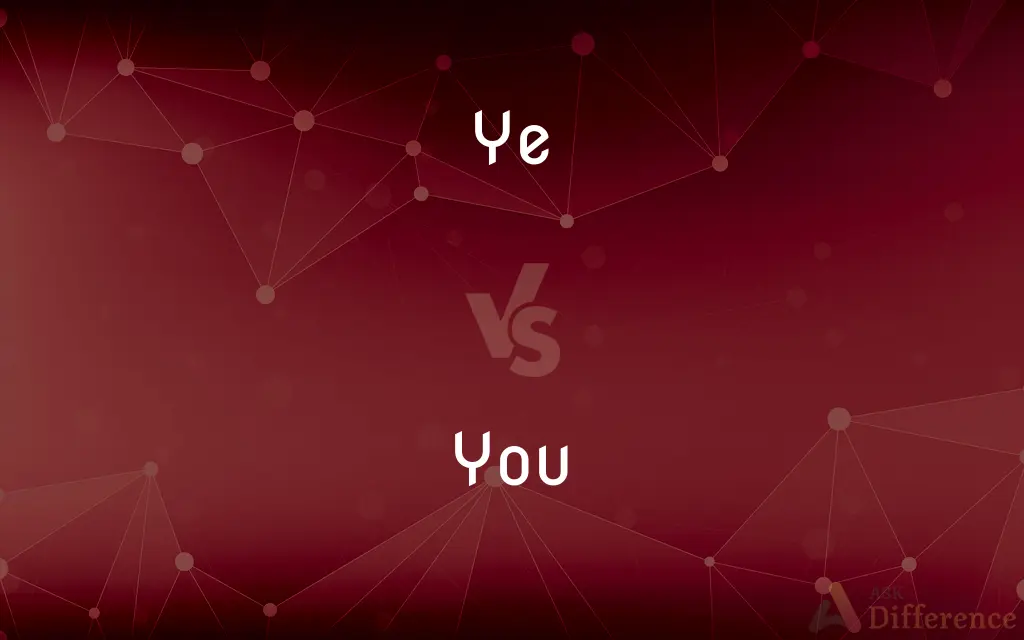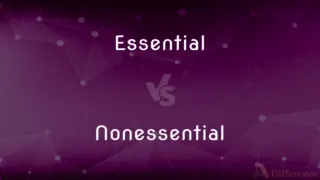Ye vs. You — What's the Difference?
By Maham Liaqat & Urooj Arif — Updated on March 12, 2024
"Ye" is an archaic or dialectal form of "you," often seen in historical texts, while "you" is the standard, modern second-person pronoun.

Difference Between Ye and You
Table of Contents
ADVERTISEMENT
Key Differences
"Ye" is an older form of the second-person plural pronoun, historically used to address a group, similar to "you all" or "you guys" today. On the other hand, "you" serves as both the singular and plural form in contemporary English, used to address one or more people.
In some dialects and historical contexts, "ye" is still used, especially in parts of Ireland and in literary or religious texts, to add an archaic or formal tone. Whereas "you" is universally understood and used in both formal and informal contexts in modern English.
The usage of "ye" often conveys a sense of antiquity or tradition, particularly in settings that aim to evoke a bygone era, while "you" is neutral, modern, and applicable in all current English-speaking contexts.
"Ye" can sometimes be found in expressions or sayings that have preserved older forms of English, contributing to a stylistic or thematic effect, whereas "you" is used in everyday language without such connotations.
While "ye" has a specific niche usage and is mostly seen in historical or stylistic contexts, "you" is a fundamental part of English grammar and is used in all kinds of communications, from casual conversations to formal writings.
ADVERTISEMENT
Comparison Chart
Usage
Archaic or dialectal, often for stylistic or traditional effect.
Standard modern English, used in all contexts.
Number
Historically plural, but can be used singularly in archaic contexts.
Both singular and plural.
Context
Historical texts, religious scripture, and certain regional dialects.
Universal usage in contemporary English.
Connotation
Conveys antiquity, tradition, or formality.
Neutral, does not inherently convey any specific tone.
Application
Limited to specific settings, such as reenactments or thematic writings.
Used in everyday communication, formal documents, and casual speech.
Compare with Definitions
Ye
An archaic or dialectal second-person plural pronoun.
Hear ye, hear ye! The court is now in session.
You
The second-person pronoun, used to address one or more persons.
You are invited to my birthday party.
Ye
Used in some dialects or regional English to denote the plural of you.
Are ye coming to the festival tomorrow?
You
Serves as a subject or object pronoun in sentences.
I saw you at the store yesterday.
Ye
In certain religious contexts, used to convey formality or reverence.
Blessed are ye who enter here.
You
Integral to both spoken and written English communication.
Can you help me with this problem?
Ye
Sometimes used in modern expressions retaining old English.
Ye gods, what have we done?
You
Used in formal and informal settings alike, across all dialects of English.
You are required to complete your forms by Friday.
Ye
In literary works, used to add an old-fashioned or historical flavor.
Ye olde tavern welcomed weary travelers.
You
Utilized in both singular and plural contexts without change in form.
Are you coming to the meeting?
Ye
Plural form of thou
Gather ye rosebuds, while ye may
You
In Modern English, you is the second-person pronoun. It is grammatically plural, and was historically used only for the dative case, but in most modern dialects is used for all cases and numbers.
Ye
Pseudo-archaic term for the
Ye Olde Cock Tavern
You
Used to refer to the person or people that the speaker is addressing
Are you listening?
I love you
Ye
(the people being addressed).
You
Used to refer to any person in general
After a while, you get used to it
Ye
(archaic) you (the singular person being addressed).
You
(object pronoun) The people spoken, or written to, as an object.
Both of you should get ready now.
Ye
(slang) Yes, yeah.
You
(To) yourselves, (to) yourself.
Ye
The Cyrillic letter Е, е, featured in various Slavic and Turkic languages.
You
(object pronoun) The person spoken to or written to, as an object. (Replacing thee; originally as a mark of respect.)
Ye
An eye.
From his yën ran the water down.
You
(subject pronoun) The people spoken to or written to, as a subject. (Replacing ye.)
You are all supposed to do as I tell you.
Ye
The plural of the pronoun of the second person in the nominative case.
Ye ben to me right welcome heartily.
But ye are washed, but ye are sanctified.
This would cost you your life in case ye were a man.
Vain pomp and glory of this world, I hate ye.
I come, kind gentlemen, strange news to tell ye.
You
(subject pronoun) The person spoken to or written to, as a subject. (Originally as a mark of respect.)
Ye
Yea; yes.
You
(indefinite personal pronoun) Anyone, one; an unspecified individual or group of individuals (as subject or object).
You
The individual or group spoken or written to.
Have you gentlemen come to see the lady who fell backwards off a bus?
You
Used before epithets, describing the person being addressed, for emphasis.
You idiot!
You
(transitive) To address (a person) using the pronoun you (in the past, especially to use you rather than thou, when you was considered more formal).
You
The pronoun of the second person, in the nominative, dative, and objective case, indicating the person or persons addressed. See the Note under Ye.
Ye go to Canterbury; God you speed.
Good sir, I do in friendship counsel youTo leave this place.
In vain you tell your parting loverYou wish fair winds may waft him over.
Common Curiosities
What is "ye" used for?
"Ye" is an archaic or dialectal form of "you," often used in historical or traditional contexts.
Is "ye" still used in modern English?
While mostly archaic, "ye" is still used in certain dialects, literary works, and thematic expressions to evoke a sense of antiquity.
Why might someone use "ye" instead of "you" in writing?
Using "ye" can add a stylistic, traditional, or historical flavor to writing, particularly in literary or thematic works.
Can "you" be used to address both one person and a group?
Yes, "you" is used as both the singular and plural second-person pronoun in modern English.
Are there any situations where "ye" and "you" are interchangeable?
In contexts that aim to evoke an archaic or formal tone, "ye" might be used interchangeably with "you," but this is generally for stylistic purposes rather than standard communication.
What is the impact of using "ye" in modern communication?
Using "ye" can be seen as quaint or charming in certain settings but might be confusing or seem out of place in regular modern communication.
How has the use of "you" evolved in English?
"You" has evolved to become the standard second-person pronoun for both singular and plural forms, simplifying English pronoun usage.
Is "ye" considered correct in contemporary English grammar?
While grammatically correct in its specific contexts, "ye" is not part of standard contemporary English and is primarily used for effect or in dialectal speech.
Can learning about "ye" help with understanding historical texts?
Yes, understanding the usage of "ye" can enhance comprehension of historical texts, literature, and cultural artifacts.
Why has "you" remained consistent in modern English?
The simplicity and versatility of "you" for both singular and plural forms have likely contributed to its consistent use in modern English.
Share Your Discovery

Previous Comparison
Essential vs. Nonessential
Next Comparison
Palm vs. VolarAuthor Spotlight
Written by
Maham LiaqatCo-written by
Urooj ArifUrooj is a skilled content writer at Ask Difference, known for her exceptional ability to simplify complex topics into engaging and informative content. With a passion for research and a flair for clear, concise writing, she consistently delivers articles that resonate with our diverse audience.














































